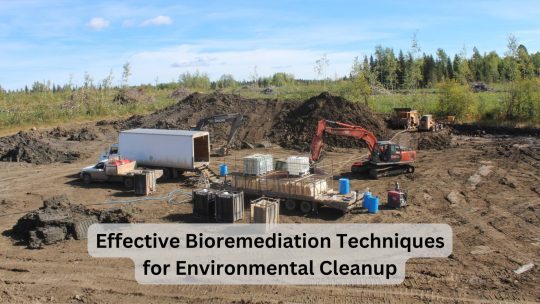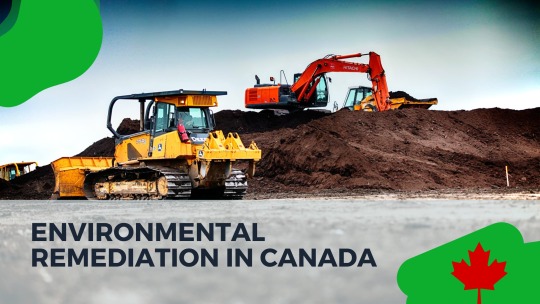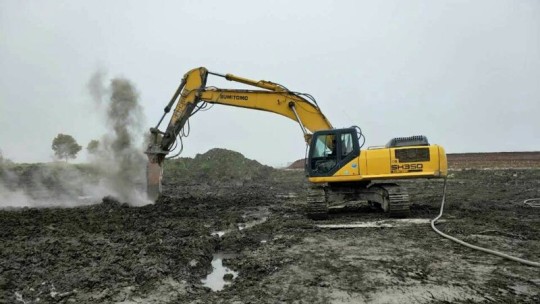#Bioventing
Text

Environmental Cleanup: Bioremediation as an Eco-Friendly Solution
Bioremediation is an eco-friendly approach that uses microorganisms or their enzymes to clean up environmental pollutants. It is a sustainable and cost-effective method to treat contaminated soil, water, and air. Bioremediation can be applied to a variety of pollutants, including petroleum, pesticides, and solvents. The process involves various biochemical reactions, microbial interactions, and environmental factors.
The principles of bioremediation are based on the natural processes of microbial degradation and plant uptake. Microorganisms have evolved to use various organic compounds as sources of energy and nutrients. They have a diverse range of enzymes that can break down complex molecules into simpler forms that can be utilized by the cell. In bioremediation, microbial degradation is enhanced by adding nutrients, oxygen, and other growth-promoting factors to the contaminated site. This can be achieved by various techniques, such as bioaugmentation, biostimulation, and phytoremediation.
There are several types of bioremediation techniques that can be applied to different types of pollutants and environments. The most common ones are in situ bioremediation, ex situ bioremediation, bioventing, biosparging, and bioreactors.
Bioremediation has been applied to a wide range of environmental pollutants and industries. Petroleum, heavy metal, pesticide, industrial waste, and landfill leachate contamination are some of the common applications of bioremediation.
Compared to traditional remediation techniques, such as excavation and incineration, bioremediation offers several benefits. It is sustainable, cost-effective, versatile, and non-invasive. Therefore, bioremediation is a promising eco-friendly solution for environmental cleanup.
#Bioremediation#Microorganisms#Environmental pollutants#delta remediation#Sustainable approach#Cost-effective cleanup#Contaminated soil#Contaminated water#Contaminated air#Petroleum#Pesticides#Solvents#Bioaugmentation#Biostimulation#Phytoremediation#In Situ Bioremediation#Ex Situ Bioremediation#Bioventing#Biosparging#Bioreactor#Heavy metal contamination#Landfills#Industrial waste#Sustainable cleanup#Non-invasive techniques#Versatile approach#Ecosystem-friendly solutions#Environmental sustainability
0 notes
Text

Effective Bioremediation Techniques: A Sustainable Solution for Environmental Cleanup
Bioremediation is a sustainable and cost-effective solution to environmental pollution, using living organisms such as bacteria and fungi to degrade pollutants into harmless compounds. There are various bioremediation techniques, including in situ (at the site of pollution) and ex situ (removing contaminants to treat elsewhere). Other methods include bioventing, biosparging, and use of bioreactors to promote the natural degradation of pollutants.
These techniques can handle a wide array of pollution types including petroleum, heavy metal, pesticide contamination, industrial waste, and landfill leachate. Benefits of bioremediation include its sustainability, cost-effectiveness, versatility, and non-invasiveness.
One company leading the way in bioremediation is Delta Remediation, based in Alberta, Canada. They specialize in applying these techniques to sites polluted with hydrocarbons, pesticides, and industrial waste, and have expanded their operations to Nigeria and Kenya.
Bioremediation thus offers a promising method for environmental cleanup, being both eco-friendly and adaptable to diverse environments. Companies like Delta Remediation are pioneering in this sector, making significant contributions to environmental health.
#Bioremediation techniques#Environmental cleanup#Sustainable solutions#Microorganisms in bioremediation#In situ bioremediation#Ex situ bioremediation#Bioventing for soil remediation#Biosparging for groundwater cleanup#Bioreactors in environmental remediation#Petroleum contamination cleanup#Heavy metal pollution remediation#Pesticide degradation#Industrial waste treatment#Landfill leachate remediation#Benefits of bioremediation#Delta Remediation#Bioremediation company#Alberta bioremediation services#Oil and gas industry cleanup#Hydrocarbon and pesticide decontamination
0 notes
Text

Bakteri Pengurai tinja 082130040233
dampaknya jika tidak ada bakteri pengurai apabila di bumi ini tidak ada pengurai, maka akan terjadi penumpukan sampah yang nantinya akan berefek pada kestabilan ekosistem, terjadi pencemaran dan akhirnya kepunahan organisme.
PT.Beone Cakra Indonesia
Jl Ksr Dadi Kusmayadi No 107 Tengah, Cibinong Bogor
Lokasi :Jawa Barat, Bogor
Jika tertarik, silahkan klik link di bawah ini!!!
wa.me/6282130040233
Marketplace :https://www.tokopedia.com/beonecakraid/penghilang-bau-toilet-bakteri-pengurai-limbah-bioxp?extParam=whid%3D10276684
Jurnal biodegradasi,bioremediasi,bakteri yang secara alami berada dalam limbah organik,biosurfaktan adalah,biodegradasi adalah,berapakah ukuran rata-rata dari bakteri,bioventing,fosfat dalam deterjen.
bakteripenguraitinja #bakteripenguraitinjaku
0 notes
Text
Mettler id5 multirange bedienungsanleitung philips
METTLER ID5 MULTIRANGE BEDIENUNGSANLEITUNG PHILIPS >> DOWNLOAD LINK
vk.cc/c7jKeU
METTLER ID5 MULTIRANGE BEDIENUNGSANLEITUNG PHILIPS >> READ ONLINE
bit.do/fSmfG
bolewivuxir.tumblr.com/post/691799707240022016/mettler-id5-multirange-bedienungsanleitung-yamaha. 0 notes. qusehawivu · a day ago. Mainboard philips 3104 313 61062 310431361062 (5 files) - Mainboard philips Mettler Toledo ID5 multirange (7 files) - Mettler Toledo ID5 multirange Bedienungsanleitung METTLER TOLEDO MultiRange Wägeterminals IND690-Base mit ID5 aus- oder einschalten Wenn ID5-MODE EIN gewählt ist, wird das IND690 Mettler ID5 MultiRange. MF-BIOVENT-S/T Platine. MHCC Sorel. Micro Rex D21. Micro Rex Mikro Rex PHILIPS Type PE 2169/00. Pilatus-Heizung elferomat. Hp elite x2 stift bedienungsanleitung · Hama 90921 bedienungsanleitung philips · Mettler id5 multirange bedienungsanleitung medion1 Bedienungs- und Installationsanleitung METTLER TOLEDO MultiRange 35 ID7-Base Einstellungen im Mastermode ID5-MODE Abwärtskompatibilität mit ID5 aus- at/iad/kaufen-und-verkaufen/kfz-zubehoer-motorradteile/philips-verstaerker- /mettler-toledo-multirange-kb-60-waegeterminal-id-5-sx-bondrucker-gd-46-
https://siniqimetor.tumblr.com/post/693856952261967872/bosch-maxx-6-bedienungsanleitung-trockner-miele, https://soniwivah.tumblr.com/post/693856948836302848/unistat-tango-bedienungsanleitung-gigaset, https://siniqimetor.tumblr.com/post/693856952261967872/bosch-maxx-6-bedienungsanleitung-trockner-miele, https://soniwivah.tumblr.com/post/693856948836302848/unistat-tango-bedienungsanleitung-gigaset, https://soniwivah.tumblr.com/post/693856948836302848/unistat-tango-bedienungsanleitung-gigaset.
0 notes
Text
البوكس نيوز - تصنيع أول جهاز تنفس صناعي مصري بنسبة 100%
البوكس نيوز – تصنيع أول جهاز تنفس صناعي مصري بنسبة 100%
تسعي جريدة البوكس نيوز بمد الجميع بالعديد حول ما سوف يتم نشره ،فنحنن نسعي جاهدين الي تبسيط والوصول لكم بكل شفافية ونتعرف اليوم علي ما تصنيع أول جهاز تنفس صناعي مصري بنسبة 100%.
أعلنت أحدى الشركات التكنولجية الناشئة المتخصصة في تصميم وتصنيع الأجهزة الطبية الالكترونية المتقدمة، عن تصنيع أول جهاز تنفس صناعي مصري بنسبة 100% وبأحدث تكنولوجيا معروفة عالمياً في هذا المجال وهو جهاز (BioVENT A…

View On WordPress
0 notes
Text
البحث العلمي والتكنولوجيا تعلن نجاح إنتاج وتوزيع أجهزة تنفس صناعي بتكنولوجيا مصرية 100%
البحث العلمي والتكنولوجيا تعلن نجاح إنتاج وتوزيع أجهزة تنفس صناعي بتكنولوجيا مصرية 100%
نهاد عادل
تلقى د. خالد عبدالغفار وزير التعليم العالي والبحث العلمي، تقريرًا مقدمًا من د. محمود صقر رئيس أكاديمية البحث العلمي والتكنولوجيا، حول مشروع دعم إنتاج أجهزة التنفس الصناعي محلية الصنع الذى تقوم به الأكاديمية تحت اسم BioVENT A series
أفاد التقرير بأن المشروع هو نتاج تعاون مثمر بين وزارة التعليم العالي والبحث العلمي من خلال المجلس الأعلى للمستشفيات الجامعية كشريك رئيسي فى التجارب…

View On WordPress
0 notes
Text
my new green gen partners notes are absolute shit oh my god
#why do you have a whole paragraph on bioventing#and nothing on pollution#he does have the laws and stuff on his notes#but he got them from my notes#oscar txt#scioly posting
2 notes
·
View notes
Text
MICROALGAE BASED SUSTAINABLE BIOREMEDIATION OF CONTAMINATED WATER: RECENT TOOL TO RESURRECT POLLUTED RIVER | UTTAR PRADESH JOURNAL OF ZOOLOGY
Nature has bestowed upon us a variety of benefits. It is also true that human irresponsibility has resulted in significant environmental damage. Pollution is an example of such irresponsibility. The beauty of nature, on the other hand, has dealt with every act of irresponsibility. The process of "bioremediation" is nothing more than a natural cure that recycles pollutants and renders them harmless and beneficial to some extent. It has been discovered to be one of the most effective strategies for cleaning up dirty river water and protecting the ecosystem. Bioremediation entails the degradation, elimination, restriction, and reclamation of several chemical and physical dangerous elements from the environment using all-inclusive microorganisms. The main concept of bioremediation is the disintegration as well as the transmutation of pollutants such as heavy metals. Algae, for example, has been discovered to be a game changer in the bioremediation process. Bioremediation techniques include bioaugmentation, biostimulation, biofilters, bioreactors, biopharming, bioventing, composting, and land farming. Each bioremediation method has its own set of benefits and drawbacks. Above all, reviving a dirty river using bioremediation will result in much less contaminated, safe, and ship-shape waterways.
Please see the link :- http://mbimph.com/index.php/UPJOZ/article/view/2659
#Bioremediation#biodegradation#polluted river#water treatment#contamination#bio stimulation#bio augmentation
0 notes
Photo

Mañana 24 de Agosto estaremos en el @bioritmefestival . 🙌🏽🙌🏽🙌🏽🙌🏽 . Para darlo todo en el escenario biovent a las 15h. . Luego nos quedamos al disfrute del festi, q ganaaaas!! . . . #bioritme #festival #marujalimon #masdeti #party #sinvacaciones #aprovechandoelcamino https://www.instagram.com/p/B1gltZmDSgf/?igshid=jotmremrzycz
0 notes
Text
Turkey’s Ventilator : BioSys Biovent
Turkey’s Ventilator : BioSys Biovent
Turkey’s Ventilator : BioSys Biovent
Biosys Biovent, it is a unique mechanical ventilator device which is used for breathing of patients with coronavirus and respiratory distress. For the first time, the domestic version of the intensive care ventilator devices technology, started mass production and 100 of them were delivered to the hospital. For the domestic mechanical ventilator device,…
View On WordPress
#2020 covid#2020 news#2020 turkey#Covid-19#covid19#news covid#news turkey#technology#technology news#Turkey’s Ventilator : BioSys Biovent
0 notes
Text

Contrasting Bioremediation Techniques: Spotting the Differences
Remediation is the process of removing contamination from water and soil, and bioremediation is a subset of this process that involves the use of living organisms to eliminate harmful pollutants in contaminated areas. Bioremediation techniques can be confusing, as some methods stimulate naturally occurring organisms to break down toxic chemicals and pathogens, while others introduce microorganisms into the environment to achieve remedial goals. There are two types of bioremediation techniques: biostimulation and bioaugmentation. These should not be confused with the two main methods of soil remediation (in-situ/ex-situ), which refer to how a remediation treatment is carried out and not the actual biology involved.
Biostimulation techniques encourage natural organisms to consume pollutants. Normally, these naturally occurring microorganisms could take decades to degrade contaminants, but by modifying the environment through the addition of nutrients, this time can be reduced. Nutrients and electron acceptors such as phosphorus, nitrogen, oxygen, or carbon are added to the environment to stimulate biodegradation. Examples of biostimulation techniques include biosparging and bioventing. Bioventing is the injection of high-pressure air (oxygen) into the soil or unsaturated vadose zone to enhance aerobic biodegradation. Biosparging is the injection of air into the saturated zone of the soil matrix or groundwater table to stimulate degradation.
Bioaugmentation involves the addition of exogenous microbial strains to supplement the degradation capacity of indigenous microbial populations. Site assessments are conducted to determine the chemical structure and concentration of contaminants, the size and nature of existing microbial populations, and the nature of the physical environment before the right bioaugmentation technique can be conducted. Effective bioaugmentation technology must be able to maintain genetic stability and viability during storage, survive in foreign and hostile environments, effectively compete with indigenous microorganisms, and move through the pores of the sediment to the contaminants. Nutrient application alone will not produce the desired remediation results, but augmenting contaminated soils with aggressive bacteria will often produce desired results in as little as 30 days.
While both techniques have applications in the remediation industry, bioaugmentation reduces the risk and uncertainty often associated with biostimulation. Delta Remediation is a worldwide leader in the area of bioremediation, offering proprietary remediation technology (BioLogix) and innovative solutions (ScreenLogix Rapid TPH Test) to meet site needs. To learn more, contact Delta Remediation at [email protected] or 780-962-7991.
#bioremediation#biostimulation#bioaugmentation#environmental science#soil remediation#microbial populations#contaminated areas#pollutants#indigenous microorganisms#exogenous microbial strains#Delta Remediation#BioLogix#ScreenLogix Rapid TPH Test.
0 notes
Text

Revitalizing Canadian Ecosystems: The Power of Environmental Remediation
Restoring Our Environment: The Significance of Environmental Remediation in Canada
Environmental remediation, a process aimed at eliminating pollutants and contaminants from soil, groundwater, and surface water, is vital for preserving Canada's abundant natural resources, safeguarding public health, and ensuring the sustainability of diverse ecosystems. With a long history of industrial and agricultural activities, environmental remediation is particularly crucial for Canada, a country with vast natural landscapes and ecosystems ranging from Arctic tundra to lush forests and freshwater resources.
Canadian Legislation and Regulations: Guiding the Remediation Process
To effectively manage contaminants and pollution, Canada implements several federal and provincial regulations that govern environmental remediation. The Canadian Environmental Protection Act (CEPA) is the primary federal legislation, while each province and territory enforces its own environmental laws and regulations, addressing site-specific contamination and remediation requirements.
Contamination Sources: Industrial and Agricultural Impact
Industrial Contaminants
From mining and oil and gas extraction to manufacturing, Canada's industrial activities have left a legacy of contamination. Common pollutants include inorganic substances such as salts and heavy metals, as well as toxic organic compounds like hydrocarbons, chlorinated solvents, and pesticides.
Agricultural Contaminants
Agricultural practices like livestock farming and crop production contribute to environmental contamination through the use of pesticides, fertilizers, and manure. These substances can leach into groundwater and surface water, posing risks to human health and ecosystems.
Harnessing Remediation Techniques: Physical, Chemical, and Biological Approaches
Physical Remediation Techniques
These techniques focus on removing, containing, or immobilizing contaminants through methods like excavation, soil washing, and solidification/stabilization.
Chemical Remediation Techniques
Chemical remediation methods employ chemical processes to transform or neutralize contaminants. Examples include chemical oxidation, reduction, and precipitation.
Biological Remediation Techniques
Biological remediation techniques utilize microorganisms to degrade, absorb, or neutralize contaminants. Methods include bioremediation (biostimulation & bioaugmentation) and bioventing.
Overcoming Challenges in Environmental Remediation
Environmental remediation projects in Canada face multiple challenges, such as:
Complex Site Conditions: Factors like mixed contaminants, extreme weather conditions, and remote locations can complicate remediation efforts.
Cost and Funding: Remediation projects can be financially burdensome, making it difficult to secure funding for large-scale efforts.
Regulatory Compliance: Navigating federal, provincial, and local regulations can be a complex and time-consuming process.
Public Perception and Stakeholder Engagement: Obtaining public support and addressing stakeholder concerns is critical for a remediation project's success.
Canadian Success Stories: Environmental Remediation in Action
Despite these challenges, Canada has seen several successful environmental remediation projects, such as:
Sydney Tar Ponds: Once one of Canada's most contaminated sites, extensive remediation efforts transformed the Nova Scotia location into a recreational green space called Open Hearth Park.
Giant Mine: A major source of arsenic contamination, this Northwest Territories mine underwent comprehensive remediation, significantly reducing risks to human health and the environment.
The Future of Environmental Remediation: Innovative Trends and Technologies
As our understanding of contaminants and ecosystems improves, innovative approaches to environmental remediation in Canada are on the horizon. Potential future developments include:
Nanotechnology: Revolutionizing the detection and treatment of contaminants with nanomaterials, such as nanoparticles and nanosensors.
Advanced Biological Techniques: Genetically engineered microorganisms or plants may offer more effective ways to break down or absorb contaminants.
Sustainable Remediation: Integrating environmental, social, and economic considerations into remediation projects can help ensure long-term sustainability and community support.
In Conclusion: The Crucial Role of Environmental Remediation in Canada
Environmental remediation is of paramount importance for protecting Canada's diverse ecosystems, natural resources, and public health. Although challenges exist, innovative technologies and techniques, combined with robust legislation and community engagement, can help address these issues and ensure a sustainable future for the country.
Frequently Asked Questions
What is environmental remediation?
Environmental remediation is the process of removing contaminants and pollutants from the environment, such as soil, groundwater, and surface water, to protect ecosystems and public health.
Why is environmental remediation important in Canada?
Environmental remediation is essential in Canada to preserve its rich natural resources, diverse ecosystems, and to mitigate the negative impacts of industrial and agricultural activities.
What are the common types of contaminants in Canada?
Common contaminants in Canada include heavy metals, hydrocarbons, and agricultural pollutants such as pesticides, fertilizers, and manure.
What are some methods of environmental remediation?
Methods of environmental remediation include physical techniques (e.g., excavation, soil washing), chemical techniques (e.g., chemical oxidation, reduction), and biological techniques (e.g., bioremediation, phytoremediation).
What are some challenges faced in environmental remediation in Canada?
Challenges in environmental remediation include complex site conditions, cost and funding issues, regulatory compliance, and public perception and stakeholder engagement.
#environmental remediation#Canada#natural resources#public health#pollution#contaminants#legislation#regulations#industrial contaminants#agricultural contaminants#physical remediation#chemical remediation#biological remediation#challenges#success stories#future trends#nanotechnology#advanced biological techniques#sustainable remediation
0 notes
Text
Vitamins, Supplements to Help COPD

COPD is a chronic obstructive pulmonary disease, which is a lung condition that makes breathing difficult by obstructing the airways of the lungs.
A common disease, it occurs most often in people who suffer from frequent episodes of bronchitis, or who have asthma or emphysema.
Although a common disease, it can become life threatening and is one of the leading major killers in the United States.
During COPD, the airways and sacs within the lungs often can become blocked. This tends to make breathing very difficult because the air can become trapped in your lungs. Exhaling becomes almost impossible and makes expelling the air difficult.
Symptoms of COPD
Symptoms of COPD often begin quietly before being noticeable. A person with COPD will worsen quickly once the symptoms are noticed.
The symptoms of COPD are a chest tightness, audible wheezing, excessive mucous secretions, a cough that lingers, shortness of breath with difficulty in performing physical activity, and/or respiratory infections that occur frequently.
Vitamins, Supplements for COPD
It is thought that because people who have COPD undergo high levels of oxidative stress that giving them antioxidants and natural anti-inflammatories could be helpful in slowing down the progression of COPD. This would, in turn, decrease their need for prescription medications, which is always a good thing.
It has been found that vitamin A may be helpful in removing the reactive form of oxygen radical in COPD. Vitamins C and E may also be beneficial vitamins in COPD although not as significant as vitamin A. Vitamin A serum levels were more apt to be lower in those with COPD.
Supplements of vitamin A for one month were found to improve performance on PFTs in some people. Vitamin C levels, which tend to be lower in patients with COPD, may help to prevent oxidant-medicated lung injury during an inflammatory COPD period and can also help to reactivate vitamin E. Vitamin E can help to decrease the risk of suffering from COPD.
Coenzyme Q10 can help to improve the oxygen levels of the blood, as well as a decrease in heart rate. N-acetylcysteine can help to protect against some toxins.
This will also help to enhance the immune system. L-carnitine boosts the immune system, improves fatty acid and glucose energy metabolism. L-carnitine has also been known to improve exercise tolerance while strengthening the muscles of the respiratory system. Bromelain helps to reduce mucous in patients with COPD.
Bromelain is found in pineapple. Omega-3 fatty acids can help with the inflammatory responses. It can improve oxygen levels and show increased improvement in pulse oximetry and shortness of breath.
If you suffer from COPD talk to your doctor about vitamin supplementation for COPD and their uses. Consider using them on a trial basis and see if any improvement is noted.
Reactions to treatment are an individualized matter. If improvement is noted, consider vitamins for COPD as an alternative form of treatment.
Effectively Help Control Chronic Asthma, Prevent Asthma Attacks
BioVent is a natural, safe and proven remedy that is a unique combination of herbal and homeopathic ingredients to assist with the management of chronic asthma, support of bronchial and respiratory health for easy breathing, and the control and prevention of asthma attacks.
Used daily, it can improve respiratory functioning and health, reduce the incidence and severity of asthma attacks and strengthen the immune system. May be combined with BronchoSoothe.
BioVent was formulated by our team of experts in natural medicine and is pharmaceutically manufactured to the highest standards.
Learn more about BioVent now.
Why do we promote this?
Save
0 notes
Text
The effect of temperature on the bioventing of soil contaminated with toluene and decane
http://dlvr.it/Pr9FcZ
0 notes
Text
Bioremediation
Bioremediation is a waste management technique that involves the use of organisms to neutralize pollutants from a contaminated site. According to the United States EPA, bioremediation is a "treatment that uses naturally occurring organisms to break down hazardous substances into less toxic or non toxic substances". Technologies can be generally classified as in situ or ex situ. In situ bioremediation involves treating the contaminated material at the site, while ex situ involves the removal of the contaminated material to be treated elsewhere. Some examples of bioremediation related technologies are phytoremediation, bioventing, bioleaching, landfarming, bioreactor, composting, bioaugmentation, rhizofiltration, and biostimulation. Bioremediation may occur on its own (natural attenuation or intrinsic bioremediation) or may only effectively occur through the addition of fertilizers, oxygen, etc., that help in enhancing the growth of the pollution-eating microbes within the medium (biostimulation). For example, the US Army Corps of Engineers demonstrated that windrowing and aeration of petroleum-contaminated soils enhanced bioremediation using the technique of landfarming. Depleted soil nitrogen status may encourage biodegradation of some nitrogenous organic chemicals, and soil materials with a high capacity to adsorb pollutants may slow down biodegradation owing to limited bioavailability of the chemicals to microbes. Recent advancements have also proven successful via the addition of matched microbe strains to the medium to enhance the resident microbe population's ability to break down contaminants. Microorganisms used to perform the function of bioremediation are known as bioremediators.
0 notes
Text
In situ bioremediation of oil contaminated soil
In today’s world, oil has become the main energy sources, large amounts of oil and its processed products enter the soil during transportation, manufacturing, and related procedures, resulting in oil contaminated soil, bring harm to the whole biosphere, is one of the most important environmental problems in the world. Bioremediation, as a potentially efficient and low-cost technology, is gaining more and more attention in the study of petroleum pollution.
The main types of bioremediation are the following:
(1)In-situ bioremediation
Refers to the contaminated soil without handling or conveying in situ bioremediation of pollution treatment, the recovery process mainly depends on its natural polluted microbial degradation
ability and create appropriate degradation conditions.
Related processing techniques are:
1.Pump/Treatment
2.Bioventing
3.Percolation
4.Diffusing
(2)Ex-situBioremediation
Refers to the bioremediation of contaminated soil in elsewhere, which transportation are limited, and more emphasis on controlling and creating a more optimized environment for degradation.
In situ bioremediation has two main characteristics, mainly lies in the simple process, low cost, small ecological risk. But in situ bioremediation has more stringent prerequisite requirements, including little or no toxic intermediates, contaminants do not contain biologically inhibitory components and so on, the it is very harsh terms, but because of tight land resources and capital costs, in situ bioremediation is the preferred method for diesel contaminated soil remediation. Composite microorganisms and plants will play a role in the diesel contaminated soil remediation process, the role of plant which is directly absorbe generated pollutants or generate microbial enzyme to promote bio chemical reaction; while the role of microorganisms is to change the content of various pollutants in soil. There is a major problem with the use of pollutants, that is, non indigenous microorganisms are difficult to maintain high activity in the local soil. When plants and microorganisms are combined, microorganisms can act as mycorrhizal fungi on the roots of plants, and metabolize some of the pollutants that cannot be metabolized through their own unique metabolic ways. At present, the main research status of in situ bioremediation is focused on three aspects: microbial activity, biodegradation of petroleum hydrocarbons, and selection with high biodegradability. In situ bioremediation still has limitations insurmountable, mainly reflected in: highly demanding for soil types, the impact of environmental factors, process vulnerable affected by small changes in concentration, end treating immature.

PARFECT provides in situ soil mixing equipment, and injecting liquid or solid stabilization agent into the soil while mixing the soil, which can be applied to diesel contaminated soil remediation and foundation consolidation project.
0 notes